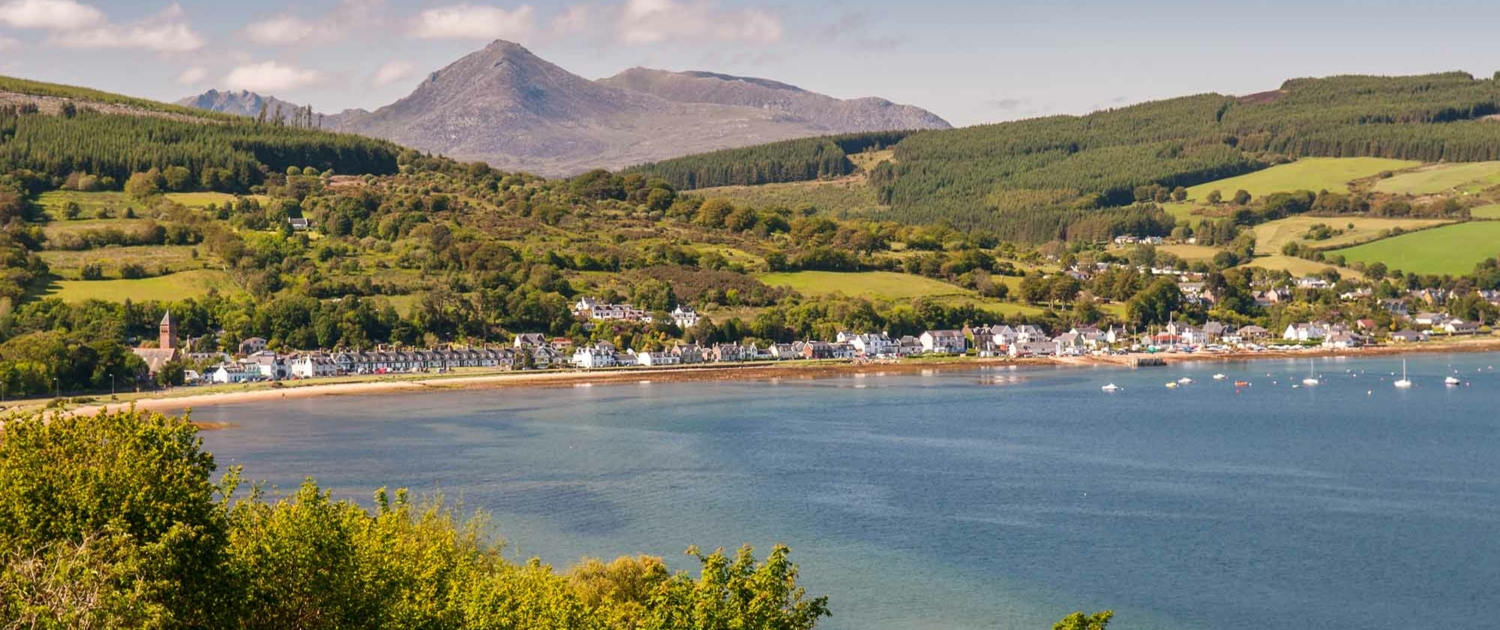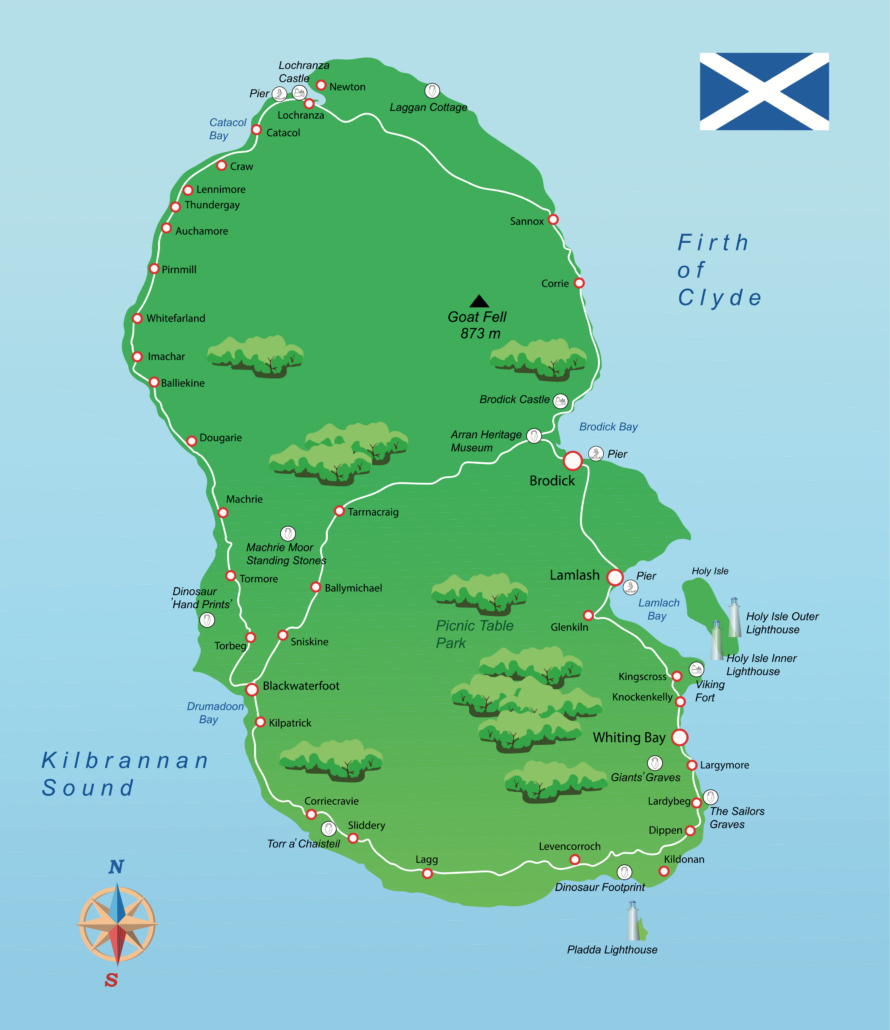Tourism in a glaciated upland area – Isle of Arran, Scotland
Why do people visit the Isle of Arran?
The Isle of Arran is an island off the west coast of Scotland. It is the seventh-largest Scottish island, at 432 square kilometres. Arran is accessible, with regular ferries from the Scottish coast, making it a popular tourist destination.
In 2017 the number of tourist visits exceeded 400,000 for the first time – generating £61 million for the island’s economy.
The physical attractions of the Isle of Arran include:
- Goatfell, the highest peak on the Isle of Arran, is the most popular natural tourist attraction. On a clear day, it is possible to see the whole island from the summit of its pyramidal peak.
- A’Chir ridge, a knife-edged aréte that separates two carries. It is the most challenging and exciting ridge on Arran. The climb is not for the faint-hearted, as there are near vertical drops on both sides.
- U-shaped valleys, such as Glen Rosa and Glen Sannox, where striations and polished rock surfaces can still be seen.
- Outdoor pursuits such as climbing, running, biking, paragliding and abseiling are popular on the Isle of Arran.
The cultural/historical attractions of the Isle of Arran include:
- Lochranza Castle, a hall house-type ruin which you can wander about, whilst Brodick Castle is a perfect example of a Victorian Hunting Lodge.
- The many standing stones around Arran.
What are the impacts of tourism on the Isle of Arran?
Tourism in the Isle of Arran has a range of social, economic and environmental impacts.
Social Impacts of Tourism on the Isle of Arran
- There is a lot of congestion, especially during peak times. Many of Arran’s upland roads are single-track, causing issues for locals and tourists.
- Jobs in tourism are typically seasonal and poorly paid.
- Tourism is helping to tackle the island’s ageing population. Families have started moving to the island after visiting it on holiday, ensuring local schools have a sustainable future.
Economic Impacts of Tourism on the Isle of Arran
- Tourist revenue was £61 million in 2017, supporting hotels, shops and restaurants.
- Nine thousand eight hundred seven locals are employed in tourism, working in shops, restaurants, hotels and other businesses.
- New businesses, such as adventure tourism, create new jobs for local people. A new whisky visitor centre recently opened at the village of Lochranza.
- Injuries and fatalities are frequent. This is not only upsetting for locals but also expensive, as Arran’s voluntary Mountain Rescue Service sometimes requires the help of expensive RAF helicopters.
Environmental Impacts of Tourism on the Isle of Arran
- The main honeypot sites and footpaths experience considerable erosion, litter, and damage to verges by cars. One of the worst affected routes is the North Goatfell Ridge.
- Ecosystems are affected by pollution from cars and boats.
- Farmland is affected by walkers leaving litter, trampling crops and disturbing sheep and cattle.
How is tourism on the Isle of Arran being managed?
Three primary issues are associated with tourism on Arran: the erosion of footpaths in popular tourist areas, climbing accidents, and the seasonal nature of the island’s tourism industry.
Managing Footpath Erosion
Some of the worst-affected parts of the Island are owned by the National Trust for Scotland. They have established a mountain path team to restore mountain paths and have raised money through the Footpath Fund Appeal. The National Trust is now doing maintenance and small-scale restoration work on mountain paths. Some have been stabilised using paving stones to create steps. This reduces soil erosion and mud flows, allowing vegetation to recover.
The National Trust aims to maintain footpaths for future generations using techniques with low environmental impact. Locally sourced materials are used whenever possible. However, the work costs up to £140 per metre.
Although the costs of footpath repairs are very high, there have been some significant improvements overall. Special attention has been paid to ensuring water drains from the paths quickly, meaning repairs are long-lasting and sustainable.
Climbing Accidents
The formation of the Arran Mountain Rescue Team dates back to 1964. Its funding comes from a combination of grant aid and public donations. This dedicated team offers search and rescue support to hikers and climbers exploring the Isle of Arran. Comprised of experienced hillwalkers and mountaineers, they know intimately about Arran’s glaciated upland areas. Operating 365 days a year, these unpaid volunteers willingly dedicate their time to assisting those in need. While the team has successfully rescued numerous individuals, unfortunately, fatalities still occur, with the most recent incidents occurring in 2015 and 2019. The Arran Outdoor Education Centre also provides safety presentations to visiting school students and staff.
The Seasonal Nature of Tourism
The Balmichael Centre and Auchrannie Resort, purpose-built attractions, play a crucial role in attracting visitors to the island during the challenging winter months when upland walking becomes less feasible. Consequently, more local residents are able to secure permanent, full-time jobs in the tourism sector. Moreover, local businesses collaborate to establish and maintain VisitArran, a new website aimed at promoting Arran as an ideal destination for short breaks or day trips.
With approximately 400,000 annual visitors, the island’s economy receives a significant boost of around £160 million. An impressive statistic reveals that nearly four out of every five tourists choose to revisit, indicating a strong affinity for Arran’s captivating upland landscapes. The advent of online bookings has contributed to this growth, allowing easier access for individuals, particularly those with ancestral ties to Scotland, such as Americans and Canadians seeking to explore the homeland of their forefathers.
Related Topics
Use the images below to explore related GeoTopics.




